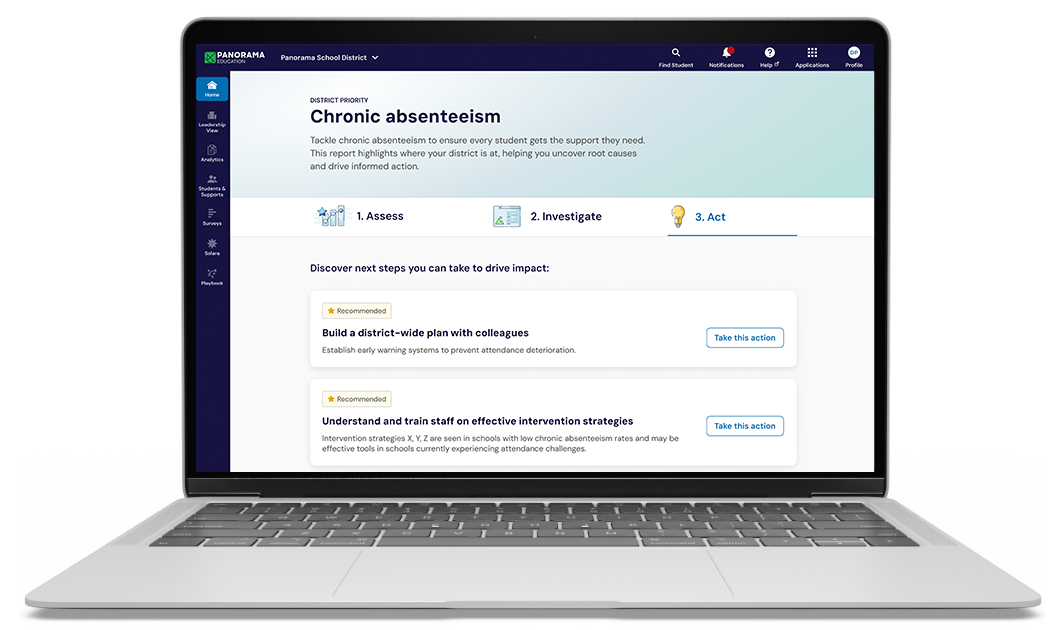Teachers know that a one-size-fits-all approaches rarely work in the classroom, as each student brings unique strengths, challenges, and paths to success. Tailored student support plans can meet these needs and help students thrive, but only if you have the time to build them.
Between full days of teaching, grading, and classroom management, documenting student needs and designing targeted interventions can easily eat up valuable planning and instruction time. Add in progress monitoring and family communication, and support planning can quickly overflow into evenings and weekends.
But what if support planning wasn’t so time-consuming? With the right tools, you can quickly create comprehensive plans for every student. This guide has the practical strategies you need to spend less time in paperwork and more time delivering personalized support to students who need it.
What Is a Student Support Plan?
A student support plan is a documented strategy that outlines interventions, goals, and monitoring processes to help students overcome academic, behavioral, or life skill challenges. These plans could also include family engagement and communication protocols, resources for at-home reinforcement, and mental health supports.
Why Are Student Support Plans Critical in K-12 Education?
Student support plans ensure that struggling learners get the timely, targeted interventions they need before small issues become obstacles to success. Today’s students face a wide range of challenges: 49% of teachers agree that chronic absenteeism remains one of the biggest problems facing schools today. Meanwhile, learning gaps continue to widen, with 70% of teachers reporting that their students are struggling academically. To turn these trends around, teachers need well-rounded student support plans that address the real issues students are facing.
By tracking attendance, grades, and behavior data, these plans help teachers identify at-risk students early, coordinate multi-faceted interventions, and track progress. They bring educators, administrators, and families together around shared goals, ensuring everyone works from the same playbook.
When implemented effectively, student support plans eliminate the guesswork and give educators a clear roadmap for turning struggling students into confident learners.
How Student Support Plans Function in K-12 Settings
Student support plans should live within your school’s multi-tiered system of supports (MTSS), connecting student data to targeted interventions across academic, behavioral, and life skills areas. These plans are often developed through bi-weekly team meetings where teachers, counselors, and administrators analyze assessment scores, behavioral observations, and attendance records to identify specific areas of need. Parents and students can actively participate in this process, ensuring buy-in and extending support beyond school walls.
Once implemented, teachers and staff monitor progress every 2-4 weeks through quick data checks that inform whether to continue, modify, or intensify interventions.
For students with existing support structures, these plans should be designed to work in harmony with IEP and 504 accommodations rather than creating redundant systems. This alignment ensures that all intervention strategies reinforce each other, maximizing impact while minimizing the documentation burden on teachers. The result is a cohesive support system that adapts as students grow and their needs change.
Essential Components of Student Support Plans
The difference between a support plan that transforms a student's trajectory and one that sits forgotten in a file drawer comes down to structure. Effective plans share specific components that make them actionable, sustainable, and responsive to student needs. Missing even one of these elements can derail the entire process, leaving teachers frustrated and students without the help they need.
Here's what to focus on when building student support strategies:
Student Profile and Baseline Data
Student data should form the backbone of your support plans. Start with comprehensive baseline data, including attendance patterns, academic performance across subjects, behavioral incident reports, and screening results. This helps you pinpoint exactly where students need assistance.
SMART Goals and Success Metrics
Set specific, measurable, actionable, relevant, and time-bound (SMART) goals tied to observable behaviors or academic benchmarks. Include both short-term (4-6 weeks) and long-term (semester) targets with clear success criteria. For example, rather than "improve reading," a SMART goal would be "increase oral reading fluency from 45 to 65 words per minute by the end of the period."
Targeted Intervention Strategies
Choose evidence-based interventions that align with your MTSS tiers and match student needs. Rather than defaulting to generic support, select specific approaches proven to address each student's identified gaps. For a student struggling with phonics, this might mean using a systematic decoding program, while a behavior support plan could integrate check-in/check-out systems or social skills groups. Document intervention frequency, duration, group size, and implementation requirements.
Progress Monitoring Schedule
Build in regular checkpoints to track whether your interventions are working. Schedule data collection every 1-2 weeks for intensive interventions or every 3-4 weeks for less urgent concerns. Use quick assessment tools like curriculum-based measures or behavior tracking sheets that take minutes to complete but provide clear evidence of growth or the need for adjustment.
Team Roles and Responsibilities
Avoid the common pitfall of assuming "everyone" will help—instead, assign specific names to specific tasks. Clearly define who will implement each intervention, collect progress data, communicate with families, and adjust the plan based on student responses.
Family and Student Voice Integration
Include structured opportunities for student self-assessment and family input, ensuring plans reflect home perspectives and student interests. When students see their own goals reflected in the plan and families feel heard, buy-in increases dramatically.
Building Your Student Support Plan: Step-by-Step Process
Follow this structured approach to develop comprehensive support plans for your students.
Step 1: Gather Comprehensive Data
Collect academic grades, standardized test scores, attendance records, behavioral incidents, teacher observations, and student/family input to create a complete picture.
Step 2: Identify Priority Areas
Analyze data to pinpoint 2-3 areas where targeted support will have the greatest impact on student success.
Step 3: Select Matched Interventions
Choose interventions with strong evidence base for your identified concerns, considering available resources and student preferences.
Step 4: Create Implementation Schedule
Build a realistic schedule that balances intervention intensity with core instruction time and other student commitments.
Step 5: Establish Progress Monitoring System
Set up data collection tools and assign team members to track progress consistently across all intervention areas.
Step 6: Schedule Review Meetings
Plan regular team meetings every 2-4 weeks to review data, celebrate progress, and adjust interventions as needed.
Common Challenges in Student Support Planning
Too many support plans fail because they're either too vague to implement or too complex to maintain. Interventions that sound good in theory, but lack the data to back them up, often end up going unused. Below are the top issues to watch out for:
Limited Time and Resources
Schools often struggle to balance intervention needs with staffing constraints. With specialists stretched thin and counselors managing large caseloads, providing individualized support to every struggling student can feel impossible.
Solution: Leverage technology, peer support systems, and creative scheduling to maximize available resources. Digital intervention programs can provide targeted practice while teachers work with small groups. Even 15-minute daily interventions can yield significant results when implemented consistently. The key is working smarter, not harder, with the resources you already have.
Inconsistent Implementation
Support plans often struggle when interventions lack structure. Different teachers might interpret strategies differently, scheduled sessions get skipped during busy weeks, or interventions gradually drift from their original design without anyone noticing.
Solution: Create implementation checklists that detail exactly what each intervention looks like in practice. Provide initial staff training and regular refreshers. Build in brief fidelity checks where team members observe interventions and compare notes. Simple tools like intervention logs or digital check-ins can track whether planned sessions actually happen.
Data Collection Overwhelm
When teachers spend more energy collecting information than acting on it, the whole system breaks down. Multiple assessments, tracking sheets, and progress forms create a paperwork headache that benefits no one.
Solution: Focus on 2-3 key metrics per goal and use digital tools to streamline collection and visualization. Choose assessments that take five minutes or less to administer. Set up simple dashboards or spreadsheets that automatically calculate growth. Schedule monthly data review meetings with clear protocols for making decisions based on the numbers.
Student and Family Engagement
Low engagement undermines plan effectiveness. Students who don't understand or buy into their goals rarely make progress, while families kept in the dark can't reinforce interventions at home. This can lead to conflicting messages between school and home, missed opportunities for practice, and students feeling like passive recipients of help rather than active participants in their own growth.
Solution: Include student voice in plan development by letting students help choose their targets and preferred interventions. Offer flexible communication options for families—some prefer texts, others want face-to-face meetings. Make family meetings welcoming and solutions-focused.
Take the Next Step: From Plan to Progress
Creating a student support plan is just the beginning now it’s time to bring it to life. Our Interventions and Progress Monitoring Toolkit gives you the practical tools to track support, measure what’s working, and make timely adjustments. Whether you're leading MTSS efforts or supporting individual students, this toolkit helps you stay focused, consistent, and responsive.
Download the Toolkit and start turning plans into real, measurable impact.





![How to Write an Intervention Plan [+ Template]](https://www.panoramaed.com/hubfs/intervention%20planning-1.jpg)

